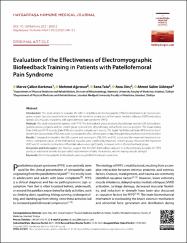| dc.contributor.author | Çalkın Korkmaz, Merve | |
| dc.contributor.author | Ağırman, Mehmet | |
| dc.contributor.author | Tolu, Sena | |
| dc.contributor.author | Dinç, Arzu | |
| dc.contributor.author | Göktepe, Ahmet Salim | |
| dc.date.accessioned | 2023-06-08T07:22:45Z | |
| dc.date.available | 2023-06-08T07:22:45Z | |
| dc.date.issued | 2023 | en_US |
| dc.identifier.citation | Çalkın Korkmaz, M., Ağırman, M., Tolu, S., Dinç, A. ve Göktepe, A. S. (2023). Evaluation of the effectiveness of electromyographic biofeedback training in patients with patellofemoral pain syndrome. Haydarpaşa Numune Medical Journal, 63(1), 46-52. https://doi.org/10.14744/hnhj.2021.90912 | en_US |
| dc.identifier.issn | 2630-5720 | |
| dc.identifier.uri | https://doi.org/10.14744/hnhj.2021.90912 | |
| dc.identifier.uri | https://hdl.handle.net/20.500.12511/11043 | |
| dc.description.abstract | Introduction: This study aimed to evaluate the effects of adding electromyographic (EMG) biofeedback to an exercise pro- gram on pain, function, and electrical activity in the isometric contraction of the vastus medialis obliquus (VMO) and vastus lateralis (VL) muscles in patients with patellofemoral pain syndrome (PFPS). Methods: The study included 30 patients with PFPS. The biofeedback group received physiotherapy and an EMG biofeedback- guided exercise program, and the control group received only physiotherapy with a home exercise program. The Visual Analog Scale (VAS) and PFPS Severity Scale (PSS) were used to evaluate pain severity. The Kujala Patellofemoral Scale (KPS) and the Func- tional Index Questionnaire (FIQ) were used to evaluate the effect of knee pain on daily living activities and lower extremity function. Results: Compared to baseline, the VAS-current and severe pain, PSS, KPS, and FIQ scores and the mean and maximum iso- metric contraction values of the VMO and VL muscles were significantly improved in both groups. However, the maximum VMO and VL isometric contraction differential values were significantly increased only in the biofeedback group. Discussion and Conclusion: Our findings suggest that the EMG biofeedback adjunct to a physiotherapy program for PFPS produces additional benefits for pain relief, improvement of daily life activities, and increasing muscle strength. | en_US |
| dc.language.iso | eng | en_US |
| dc.publisher | Haydarpaşa Numune Training and Research Hospital | en_US |
| dc.rights | info:eu-repo/semantics/openAccess | en_US |
| dc.rights | Attribution-NonCommercial 4.0 International | * |
| dc.rights.uri | https://creativecommons.org/licenses/by-nc/4.0/ | * |
| dc.subject | Electromyographic Biofeedback | en_US |
| dc.subject | Exercise | en_US |
| dc.subject | Patellofemoral Pain Syndrome | en_US |
| dc.title | Evaluation of the effectiveness of electromyographic biofeedback training in patients with patellofemoral pain syndrome | en_US |
| dc.type | article | en_US |
| dc.relation.ispartof | Haydarpaşa Numune Medical Journal | en_US |
| dc.department | İstanbul Medipol Üniversitesi, Tıp Fakültesi, Dahili Tıp Bilimleri Bölümü, Fizik Tedavi ve Rehabilitasyon Ana Bilim Dalı | en_US |
| dc.authorid | 0000-0003-1757-1814 | en_US |
| dc.authorid | 0000-0002-1111-3110 | en_US |
| dc.authorid | 0000-0002-4232-3217 | en_US |
| dc.authorid | 0000-0002-1166-1141 | en_US |
| dc.identifier.volume | 63 | en_US |
| dc.identifier.issue | 1 | en_US |
| dc.identifier.startpage | 46 | en_US |
| dc.identifier.endpage | 52 | en_US |
| dc.relation.publicationcategory | Makale - Ulusal Hakemli Dergi - Kurum Öğretim Elemanı | en_US |
| dc.identifier.doi | 10.14744/hnhj.2021.90912 | en_US |
| dc.institutionauthor | Ağırman, Mehmet | |
| dc.institutionauthor | Tolu, Sena | |
| dc.institutionauthor | Dinç, Arzu | |
| dc.institutionauthor | Göktepe, Ahmet Salim | |
| dc.identifier.trdizinid | 1176031 | en_US |



















